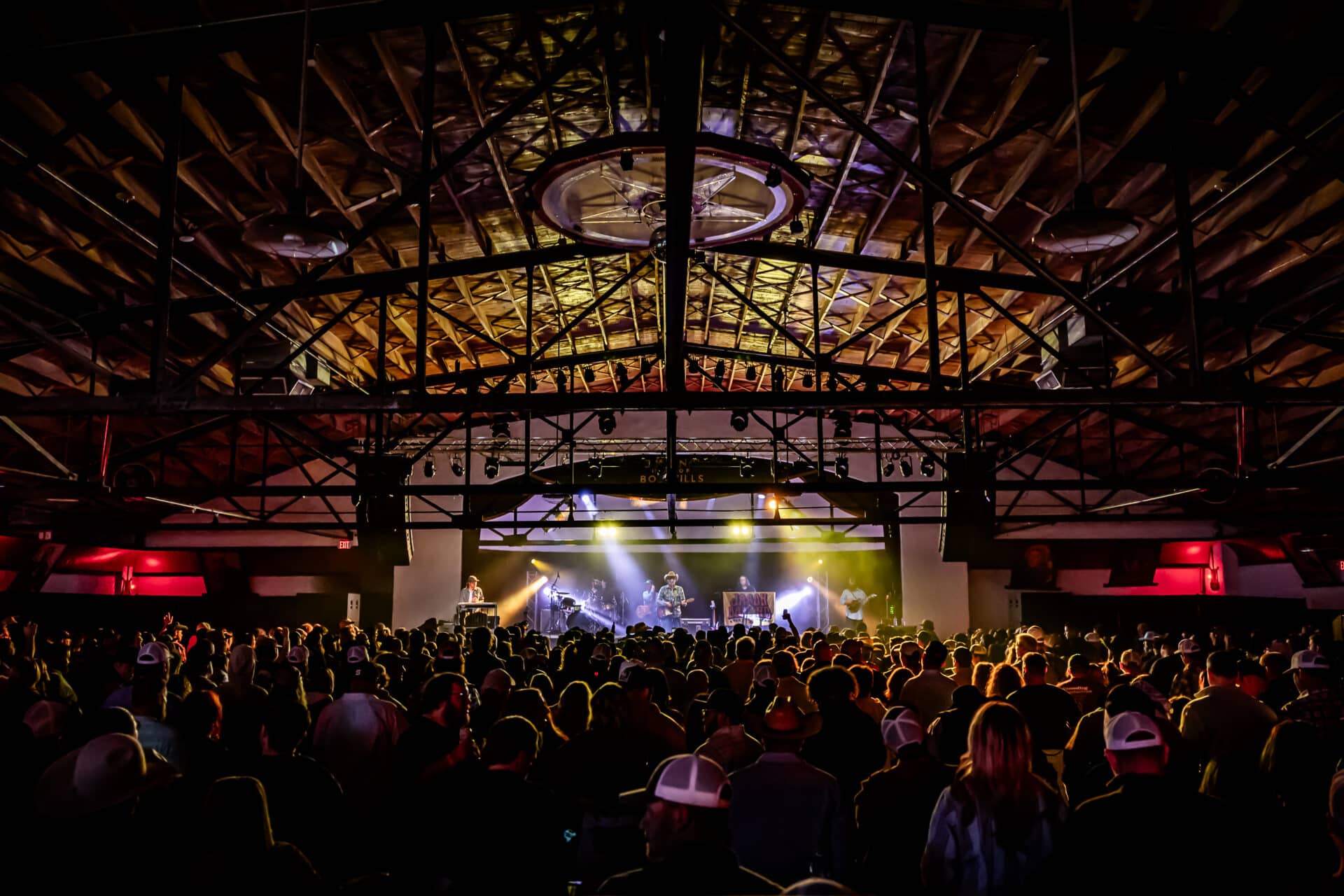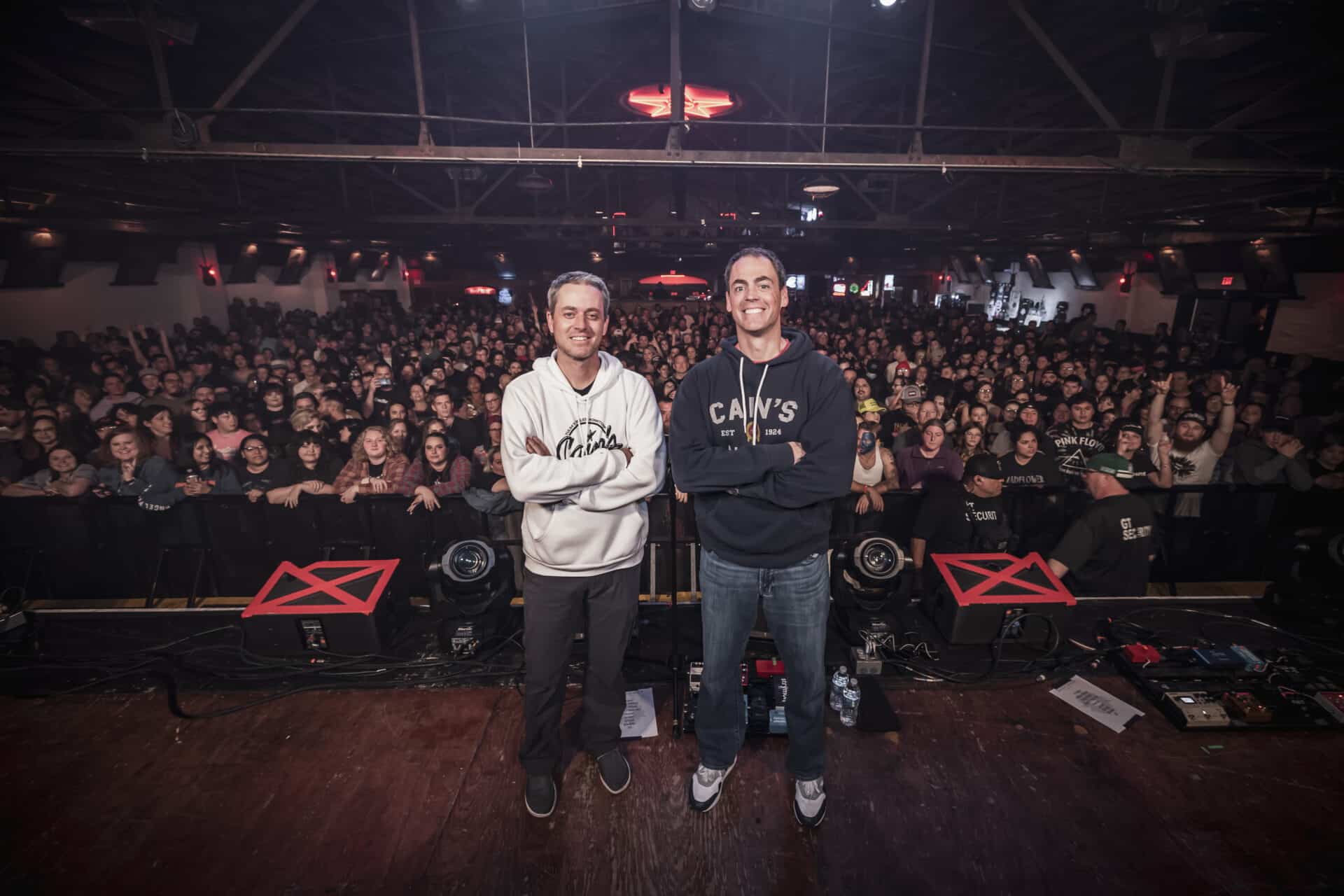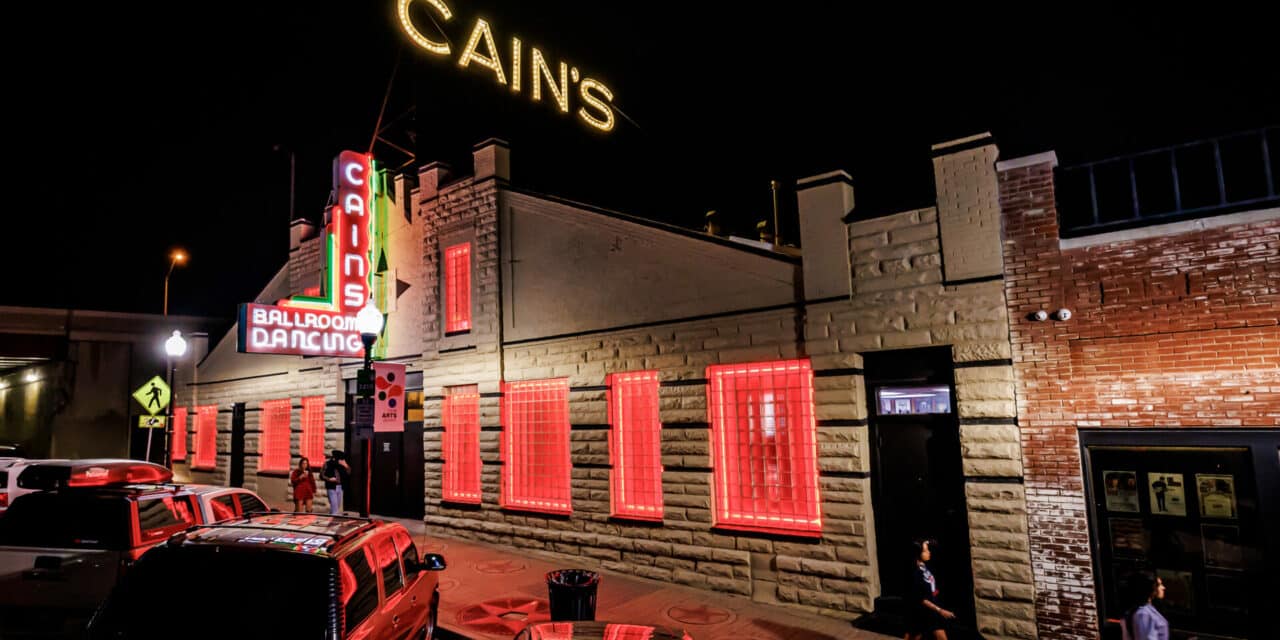CENTENNIAL CELEBRATION: The storied Cain’s Ballroom in Tulsa turns 100 years old this year, still as a very active concert venue. (Phil Clarkin)
Cain’s Ballroom co-owner Chad Rodgers was chatting with Elvis Costello after his performance a few years ago at the historic Tulsa, Oklahoma venue, when the British singer-songwriter told Rodgers something that’s stuck in his mind ever since.
“His father told him when he was growing up, that he’ll know he made it in the industry when he played Cain’s,” Rodgers said.
Ross McManus, Costello’s dad and a musician himself, knew what he was talking about. There’s a poster on the wall inside the ballroom from Costello’s early 1980s show at Cain’s.
His father’s insight speaks volumes to the global influence tied to the venerable ballroom, which turns 100 years old in 2024.
Some things have changed over time at Cain’s Ballroom, as Chad Rodgers and his brother, Hunter, have made improvements to the facility over the 22 years they’ve owned it. In addition, the dynamic of the music itself has morphed over multiple generations.
The fact that it remains standing a century after it opened, a vibrant and key piece of the Oklahoma music scene, is a credit to the local folks that recognize its place in American pop culture and were committed to preserving the shrine to live entertainment.
Over time, the club’s owners and the Tulsa community have seen trends come and go, from the early days when western swing’s Bob Wills & His Texas Playboys first took the stage 1935 to the ‘70s punk era with the Sex Pistols and Ramones; from country’s resurgence and goth rock in the ‘90s; to Christone “Kingfish” Ingram keeping the Mississippi Delta blues tradition alive deep into the 21st century.
Offbeat events have also called Cain’s home, from women’s mud wrestling to former Oklahoma City Thunder and NBA All-Star Russell Westbrook’s comedy routine.
One thing has remained constant — Cain’s ability to attract patrons at a young age to help shape their musical tastes.
“What people don’t really think about these days is, when Bob Wills ruled Cain’s, he was drawing people 16 to 38 years old primarily as the demographic,” said Larry Schaeffer, who owned the ballroom for 25 years as a promoter with Little Wing Productions. “Since that time, it’s always been a building that draws the younger generation.”
Over the past century, Cain’s Ballroom has drawn a who’s who of rock royalty, with legacy bands such as U2, The Police, Pretenders, Bon Jovi and Van Halen, performing there during the early stages of their careers.
Schaeffer booked them all at the ballroom during his ownership tenure from 1976 to the late 1990s.
The Sex Pistols got paid $500, Van Halen $1,500 and The Police $3,000.
“When I got in there, the big agencies that controlled most of the artists were unaware of it,” Schaeffer said. “Tulsa was not an automatic stop for tours, and we had to work hard for them to recognize us. I booked all over the map, throwing darts, picking up as many styles of music as I could, even though I was a Hendrix fan. Business multiplied and we became the go-to destination.”
Schaeffer, now 75, grew up in Tulsa and knew all about the storied history behind the ballroom, built in 1924 by entrepreneur Tate Brady.
Over the years, it was a garage, dime-a-dance joint and a dancing academy before it eventually turned into a concert venue.
In 1976, he bought Cain’s Ballroom for $60,000 after building enough capital to meet the asking price, due in part to the Peter Frampton/Santana/Gary Wright concert he had recently promoted at the height of Frampton’s career.
“Little Wing is 53 years old, and all that time, I’ve always been one step ahead of the wolf,” Schaeffer said.
After Schaeffer bought the ballroom, his parents helped him remodel the place. His mother came in with a neighbor to repaint the walls and the old drop ceiling. His father, a plumber, came in and repaired the toilets to make sure they flushed consistently.
Schaeffer didn’t have enough money to fix the leaky roof, so he waited until a major hail storm came through Tulsa for insurance to kick in and pay for a new roof. That happened on two separate occasions, he said.
The room itself was mostly left intact under Schaeffer’s stewardship, featuring sepiatone portraits of, among others, country pioneers Ernest Tubb, Tennessee Ernie Ford, Hank Thompson, Roy Acuff and Little Jimmy Dickens lining the ballroom walls. They all graced the Cain’s stage.
“What makes it special is there’s so much DNA soaked into those walls, starting with Bob Wills,” he said. “The first time I walked in there, I literally got a chill up my back. I knew something big musically had happened there. It’s affected a lot of artists too. When Beck played Cain’s in the ‘90s, he came to sound check and didn’t leave the building. He just moved his chair from one spot to the next. He told me if he had his way, he wouldn’t play anyplace else, ever.”
As the millennium loomed, Schaeffer, who took over Cain’s at age 27, felt his ownership had run its course. He sold the ballroom to Danny and Mark Finnerty, who owned it for a few years before selling Cain’s to the Rodgers family in 2002.
The family were all music lovers, and in a whirlwind of a transaction over the course of five days, the Rodgers clan acquired Cain’s Ballroom. Chad and Hunter Rodgers, sons of Jim Rodgers, a Tulsa neurosurgeon who died in May 2023, were given the keys to run the ballroom, green behind the ears. At the time, they were both in their 20s and had no experience in the music industry.
Now, they’re grizzled veterans, more than two decades after Dwight Yoakam, the first show under their ownership, performed on Oct. 1, 2003. They split the duties of booking, marketing and ticketing for the 1,700-capacity venue, supported by seven full-time employees.
The Rodgers brothers invested a few million dollars to renovate the ballroom, which is part of the National Register of Historic Places.
The improvements included removing the drop ceiling to expose the barrel-shaped dome roof, new lights and sound and the installation of HVAC and fire sprinkler systems, which, to that point, the ballroom never had.
The upgrades extended to purchasing a side building to the south of Cain’s to build new restrooms.
The ballroom’s original setup had eight women’s stalls and two troughs and two stalls for men, woefully inadequate for concert crowds, Chad Rodgers said.
Mac’s BBQ, a local eatery and the fourth restaurant the brothers have used over the years at Cain’s, serves brisket, hot links, Frito pie and pig pen nachos, topped with pulled pork and candied jalapenos.

RED DIRT REDUX: Jason Boland and the Stragglers, shown at Cain’s Ballroom in November 2023. (Phil Clarkin)
The weathered wood dance floor was replaced. There’s no truth to the decades-long rumor that the floor was spring-loaded from Dodge truck springs buried beneath the surface. The floor still gives off a bouncing sensation when the crowd is dancing up a storm.
“It sounds weird, but when you’re here with a full house, the floor moves,” said Julie Watson, a local writer and radio broadcaster covering the Tulsa music community and a big supporter of Cain’s Ballroom.
Paul Benjamin, a local musician, has played the ballroom a few dozen times in various incarnations, from supporting national acts to participating in fund-raisers for area colleagues.
For three years, he served as music director for NPR’s “Live from Cain’s,” a radio program showcasing the historic venue.
The stage itself “is so marinated, that when you get on it, you feel like you’re connected with so many styles of music and people, all the way back to Bob Wills,” Benjamin said. Touring artists specifically seek out Cain’s because they want to play it and become part of its history, according to Benjamin. Green Day is one example, kicking off their 2021 world tour at the ballroom.
The same is true for Jack White, who has a home in Tulsa.
“They could play much larger venues in the area, but they love the feel and the vibe of Cain’s and go out of their way to come here,” Benjamin said. “It’s widely revered, one of the last places in the country like it.”
Robert Plant is also one of those artists. Plant goes on tour this year, once again teaming with bluegrass musician Alison Krauss, and they’re kicking it off at Cain’s Ballroom on June 2.
The show is among the highlights of the venue’s centennial celebration. Tickets run $100 to $150, the most expensive to date in the ballroom’s history, Chad Rodgers said.
Jason Isbell and the 400 Unit, booked for May 5-6 at Cain’s, is another tentpole moment in the celebration, he said.
Looking back, two Oklahoma-born acts are among the concert memories that stand out for the Rodgers brothers.
Zach Bryan performed a doubleheader at the ballroom in 2021, shortly before he blew up into becoming a stadium headliner three years later.
The Turnpike Troubadours reintroduced themselves to the world after taking three years off.

BROTHERS IN ARMS: Cain’s Ballroom co-owners Chad and Hunter Rodgers have made extensive renovations to the facility over the 22 years they’ve owned it. (Phil Clarkin)
The red-dirt country band’s first two shows back in the saddle were at Cain’s in April 2022. Years ago, they played a side room for 200 people, Chad Rodgers said.
“They have a song called Easton & Main, which is the intersection in front of the ballroom,” he said. “To hear that song in this building, with the lyrics ‘on the Cain’s Ballroom floor, soakin’ up a bourbon stain,’ — it gives me chills.”
Moving forward, the Rodgers boys feel good about the ballroom going strong for another 100 years. Early in the 2024 calendar, Cain’s has more sold-out shows than ever before under their tutelage.
People are hungrier than ever for live music, Hunter Rodgers said. Hanging on to the ballroom during the pandemic proved to be nerve wracking, the brothers acknowledged. They reopened after a four-month shutdown with restricted capacity shows. During that time, they rebuffed a few predators that came knocking on their door to see if they were interested in selling Cain’s at a bargain price.
The Rodgers brothers said no thanks. They invested a lot of time and money into the ballroom, a true gem for Tulsa and the world, for that matter, and didn’t care to throw it all away.
Joining the new National Independent Venues Association, which successfully lobbied the federal government for financial relief during the shutdown, gave them comfort, knowing others were in the same situation.
Cain’s received some of that money through the Shuttered Venue Operators Grant.
“This venue has always been independently owned and it would be nice to keep it that
way,” Hunter Rodgers said. “It’s hard when there’s lots of big promoters out there. It’s amazing that we’ve fit 100 years of history in this building. There’s lots more history to be made.”







